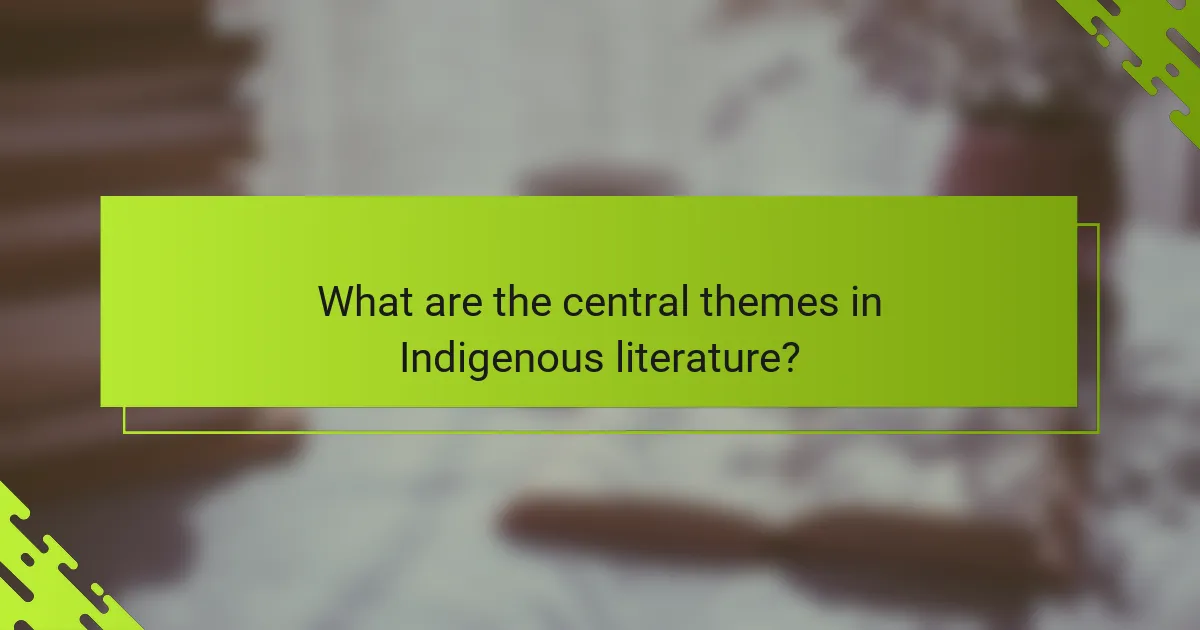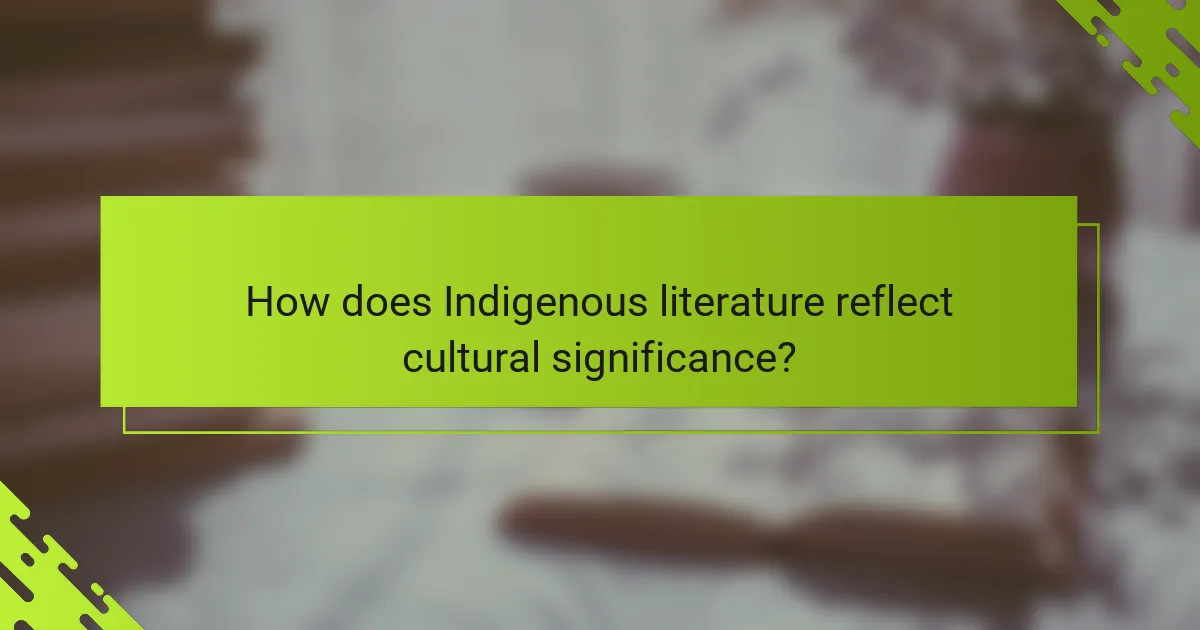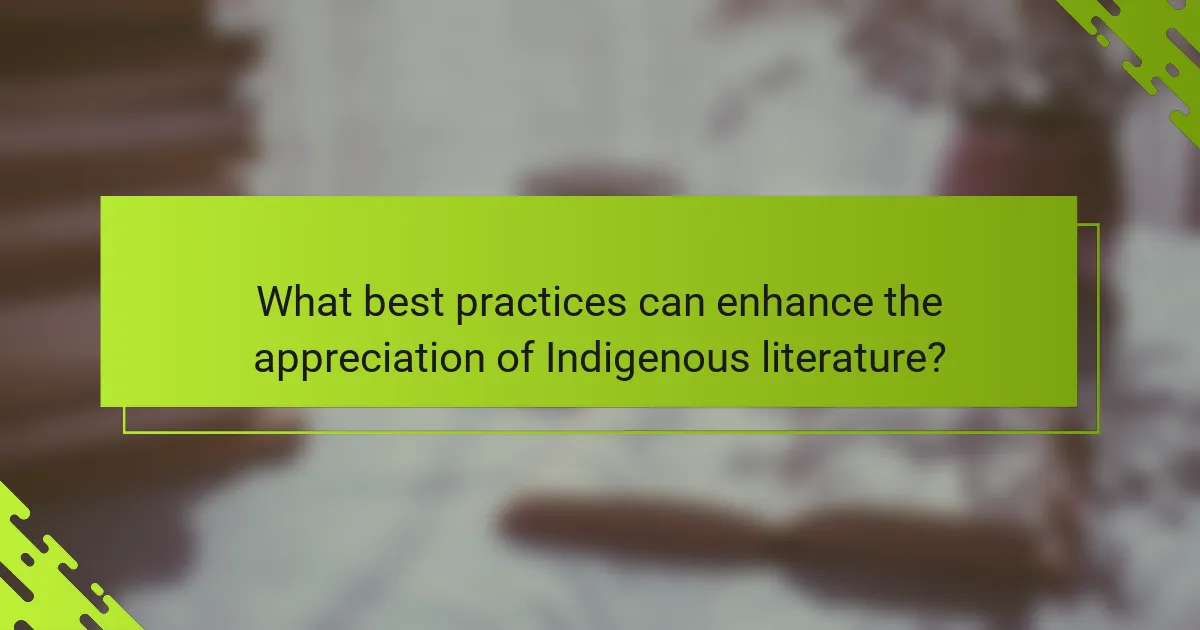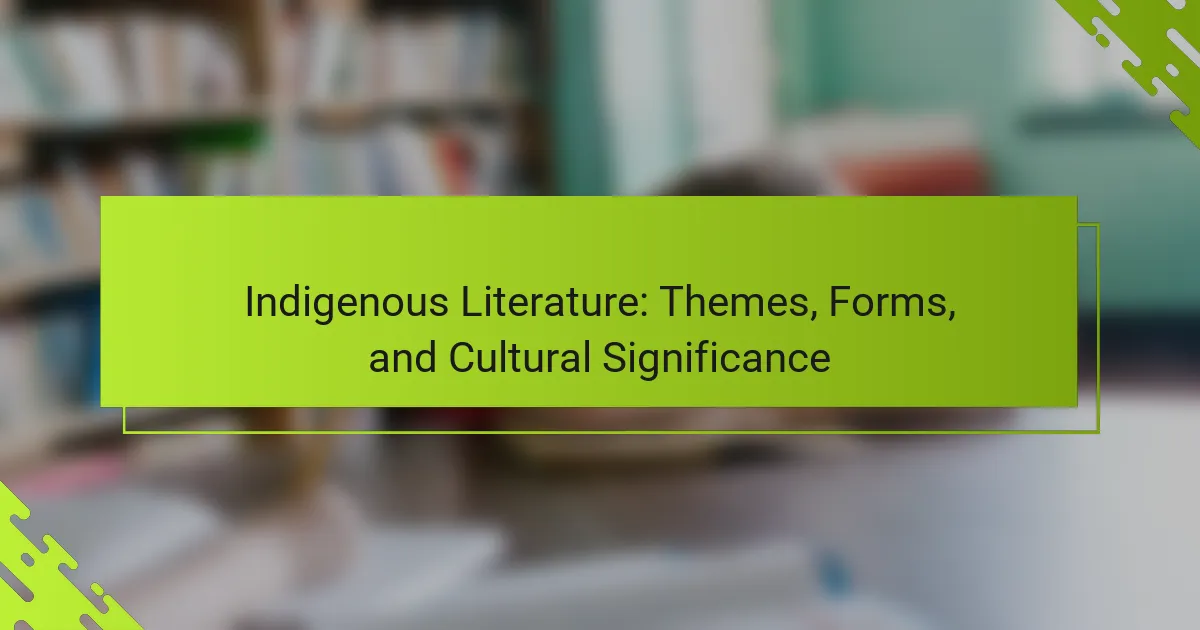Indigenous literature plays a crucial role in preserving cultural heritage and addressing contemporary issues. This article explores central themes like identity and resilience, diverse forms such as oral traditions and poetry, and the cultural significance of these narratives. It also highlights the challenges faced by Indigenous authors, including cultural appropriation and underrepresentation in mainstream literature. Engaging with these texts fosters a deeper understanding of Indigenous perspectives and experiences.

What are the central themes in Indigenous literature?
Indigenous literature often explores themes of identity, cultural connection, and resilience. Central themes include the relationship to land, the impact of colonisation, and the expression of spirituality. These works frequently highlight oral traditions and storytelling as vital forms of cultural preservation. Additionally, they address social justice issues and the ongoing struggles of Indigenous peoples, emphasising the importance of community and heritage.
How do oral traditions influence storytelling?
Oral traditions significantly influence storytelling by preserving cultural heritage and fostering community identity. These traditions emphasise collective memory through shared narratives, often passed down through generations. Indigenous literature reflects this influence by incorporating themes of nature, spirituality, and ancestral wisdom. Oral storytelling techniques, such as repetition and rhythm, enhance engagement and retention, making stories memorable and impactful. Such practices ensure that cultural values and historical events remain alive in the community’s consciousness.
What role does spirituality play in narratives?
Spirituality plays a vital role in Indigenous narratives by connecting cultural identity, tradition, and the natural world. It influences storytelling methods, often weaving spiritual beliefs into the fabric of the narrative. This integration highlights the importance of ancestral wisdom and communal values. Indigenous literature frequently reflects on the relationship between humans and the environment, emphasising a holistic worldview. Spiritual themes can manifest through symbolism, rituals, and the oral tradition, enriching the narrative experience and fostering a deeper understanding of cultural significance.
How is identity explored through characters and plots?
Identity in Indigenous literature is explored through characters and plots by reflecting cultural values and historical experiences. Characters often embody communal identities, showcasing resilience and connection to land. Plots frequently address themes of displacement, cultural survival, and the impact of colonisation. These narratives reinforce the significance of storytelling as a means of preserving identity and heritage. Through diverse forms, such as oral traditions and written texts, Indigenous literature articulates unique perspectives and fosters a deeper understanding of cultural identity.
Which social issues are commonly addressed in Indigenous texts?
Indigenous texts commonly address social issues such as identity, land rights, cultural preservation, and systemic inequality. These themes reflect the unique experiences and challenges faced by Indigenous communities. For example, many narratives explore the impact of colonisation on cultural identity. Additionally, issues like environmental stewardship and intergenerational trauma are frequently highlighted, emphasising the connection between land and Indigenous identity. These texts serve as a platform for raising awareness and fostering understanding of these critical social issues.

What forms and genres are prevalent in Indigenous literature?
Indigenous literature encompasses various forms and genres, including oral traditions, poetry, novels, and plays. Oral storytelling remains a foundational aspect, preserving cultural history and identity. Poetry often reflects the connection to nature and spirituality, while novels and plays explore contemporary issues and experiences. Each genre serves to convey the rich cultural significance and diverse perspectives within Indigenous communities.
How does poetry serve as a vehicle for cultural expression?
Poetry serves as a powerful vehicle for cultural expression by conveying the experiences, traditions, and values of Indigenous communities. It encapsulates historical narratives, spiritual beliefs, and social issues, allowing for a deep connection to identity and heritage. Through various forms, such as oral traditions and written verse, Indigenous poetry reflects unique cultural attributes and fosters a sense of belonging. This art form often addresses themes like land, ancestry, and resilience, making it a vital means of preserving and promoting cultural significance.
What distinguishes Indigenous novels from mainstream literature?
Indigenous novels are distinguished from mainstream literature by their deep cultural roots, unique storytelling techniques, and focus on community and identity. These works often explore themes of colonisation, resilience, and the connection to land.
Indigenous narratives frequently employ oral traditions, blending myth and history, which contrasts with the linear storytelling common in mainstream literature. The characters are often representatives of their communities, reflecting collective experiences rather than individual journeys.
Additionally, Indigenous literature emphasises cultural practices and languages, showcasing unique attributes that may not be present in mainstream works. This cultural significance fosters a deeper understanding of Indigenous perspectives and experiences.
How are plays and performances used to convey Indigenous stories?
Plays and performances effectively convey Indigenous stories by utilising traditional narratives and cultural expressions. They serve as a medium for storytelling, preserving history, and fostering community identity. Through live performances, audiences experience the emotional depth and cultural significance of Indigenous experiences, often incorporating unique attributes like language, music, and dance. These elements enhance the authenticity and impact of the stories shared, bridging the gap between generations and promoting understanding of Indigenous perspectives.

How does Indigenous literature reflect cultural significance?
Indigenous literature reflects cultural significance by preserving traditions, values, and histories of Indigenous peoples. It serves as a medium for storytelling, identity expression, and cultural resilience. Through diverse themes such as connection to land, spirituality, and community, Indigenous literature articulates unique worldviews. This literature often includes oral traditions, poetry, and narratives that emphasise the importance of relationships with nature and ancestors. By engaging with these texts, readers gain insight into the rich cultural heritage and contemporary issues faced by Indigenous communities.
What is the impact of storytelling on community identity?
Storytelling significantly shapes community identity by preserving traditions and fostering a sense of belonging. Indigenous literature often encapsulates cultural narratives, reinforcing shared values and experiences. These stories serve as vital tools for cultural transmission, ensuring that languages, customs, and histories are passed down through generations. As a result, storytelling not only strengthens community bonds but also enhances individual identity within the larger cultural framework. The themes and forms found in Indigenous literature highlight the unique attributes of each community, showcasing their distinct worldviews and experiences.
How do Indigenous authors reclaim narratives through literature?
Indigenous authors reclaim narratives through literature by expressing cultural identity and challenging stereotypes. They utilise storytelling techniques that reflect traditional oral histories, preserving their heritage. This literature often addresses themes of colonisation, resilience, and community, fostering a deeper understanding of Indigenous experiences. By centring their voices, these authors reshape perceptions and empower future generations.
In what ways does literature serve as a form of resistance?
Indigenous literature serves as a form of resistance by preserving cultural identity and challenging colonial narratives. It articulates the experiences and histories of Indigenous peoples, often highlighting struggles against oppression. Through storytelling, it fosters community resilience and promotes social justice. This literature frequently employs unique forms, such as oral traditions and contemporary poetry, to convey messages of resistance. By reclaiming their narratives, Indigenous authors assert their rights and affirm their existence in the face of marginalisation.

What unique attributes define Indigenous literary voices?
Indigenous literary voices are defined by their unique cultural perspectives, oral traditions, and connection to land. These attributes reflect the experiences and histories of Indigenous communities. The use of storytelling techniques, such as nonlinear narratives and symbolism, distinguishes their literature. Additionally, themes of identity, resilience, and community are prevalent, emphasising the importance of heritage and belonging.
How do regional variations shape storytelling techniques?
Regional variations significantly influence storytelling techniques in Indigenous literature by shaping narratives, themes, and cultural expressions. Different landscapes, histories, and languages contribute to unique storytelling forms. For instance, oral traditions often reflect local customs and beliefs, while written forms may incorporate regional dialects and symbolism. These variations enhance cultural significance, allowing stories to resonate with specific communities. Additionally, storytelling techniques adapt to preserve traditions amid changing contexts, demonstrating resilience and innovation within Indigenous cultures.
What are the influences of colonisation on contemporary Indigenous writers?
Colonisation significantly shapes contemporary Indigenous writers through themes of resilience, identity, and cultural reclamation. Indigenous literature often reflects the impacts of historical trauma while emphasising the importance of storytelling in preserving cultural heritage.
Contemporary Indigenous writers draw from their unique experiences, blending traditional narratives with modern forms. This fusion creates a distinct voice that challenges colonial narratives and asserts Indigenous identities.
Moreover, the exploration of land and connection to nature remains a central theme. Writers use their work to advocate for environmental justice and highlight the significance of ancestral lands.
As a result, Indigenous literature today serves as a powerful medium for activism, healing, and cultural continuity, allowing writers to address contemporary issues while honouring their roots.

What are the challenges faced by Indigenous authors today?
Indigenous authors face significant challenges today, including cultural appropriation, limited access to publishing opportunities, and underrepresentation in mainstream literature. These issues hinder their ability to share authentic narratives and perspectives.
Cultural appropriation often distorts Indigenous stories, leading to misrepresentation. Limited access to publishing resources restricts visibility and market reach for Indigenous voices. Underrepresentation in literary awards and media further marginalises their contributions.
Additionally, systemic barriers in education and funding create obstacles for aspiring Indigenous writers. These challenges collectively impact the preservation and promotion of Indigenous literature and its cultural significance.
How do publishing barriers affect visibility and representation?
Publishing barriers significantly limit visibility and representation of Indigenous literature. These barriers include restricted access to publishing platforms, lack of funding, and cultural misunderstandings.
Indigenous authors often face challenges in promoting their works, leading to underrepresentation in mainstream literature. This impacts the cultural significance of their narratives, which are essential for preserving Indigenous identities and histories.
Furthermore, the absence of diverse voices in publishing perpetuates stereotypes and misrepresentation. Increased accessibility and support for Indigenous literature can enhance visibility and foster a richer literary landscape.
As a result, addressing these barriers is crucial for promoting authentic representation and ensuring that Indigenous stories reach wider audiences.
What role does audience reception play in the success of Indigenous works?
Audience reception is crucial to the success of Indigenous works as it shapes visibility and cultural impact. Positive reception can enhance recognition and appreciation of Indigenous narratives, promoting cultural understanding. Engaging storytelling resonates with diverse audiences, fostering empathy and connection. The unique perspectives offered in Indigenous literature can challenge stereotypes, contributing to broader societal discussions. Ultimately, audience engagement amplifies the significance of these works, ensuring their relevance in contemporary discourse.
How can Indigenous literature be preserved for future generations?
Indigenous literature can be preserved for future generations through documentation, education, and community engagement. Archiving oral traditions and written works ensures accessibility. Educational programs that emphasise Indigenous narratives foster appreciation and understanding. Collaborating with Indigenous communities in storytelling projects strengthens cultural connections and promotes authenticity. Digital platforms can also broaden reach and safeguard these literary forms against loss.

What best practices can enhance the appreciation of Indigenous literature?
To enhance the appreciation of Indigenous literature, engage with the cultural contexts and themes that define it. Understanding the historical significance and diverse forms of expression deepens connections.
1. Promote Indigenous voices through events and workshops.
2. Encourage educational programs that include Indigenous literature in curricula.
3. Foster discussions around themes like identity, land, and resilience.
4. Support Indigenous authors by purchasing their works and sharing them widely.
5. Collaborate with Indigenous communities to ensure authentic representation.
How can readers engage with texts respectfully and meaningfully?
Readers can engage with Indigenous literature respectfully and meaningfully by approaching the texts with an open mind and a willingness to understand diverse cultural perspectives. Recognising themes such as identity, resilience, and connection to land enhances appreciation. Engaging with the forms of storytelling unique to Indigenous cultures, including oral traditions and narrative structures, fosters deeper connections. Additionally, acknowledging the cultural significance of these works promotes respectful dialogue and critical reflection on historical contexts. By valuing Indigenous voices, readers contribute to a more inclusive literary landscape.
What resources are available for deeper exploration of Indigenous themes?
Numerous resources are available for exploring Indigenous themes in literature. These include scholarly articles, anthologies, and online platforms dedicated to Indigenous voices.
Key resources feature the following:
1. Anthologies of Indigenous literature showcasing diverse voices.
2. Academic journals focused on Indigenous studies and themes.
3. Online databases providing access to Indigenous authors and works.
4. Documentaries and films that explore Indigenous narratives.
5. Cultural centres and libraries offering workshops and readings.
6. Websites dedicated to Indigenous literature and storytelling.
These resources facilitate a deeper understanding of the themes, forms, and cultural significance of Indigenous literature.
Which common misconceptions should be avoided when discussing Indigenous literature?
Common misconceptions about Indigenous literature include viewing it as a monolithic genre, misunderstanding its cultural context, and underestimating its diversity. Many assume all Indigenous works focus solely on traditional themes, neglecting contemporary issues and varied forms of expression. Additionally, some people mistakenly believe Indigenous authors only write for Indigenous audiences, ignoring their universal appeal and relevance. Recognising these misconceptions enhances appreciation for the rich tapestry of Indigenous narratives and their cultural significance.
